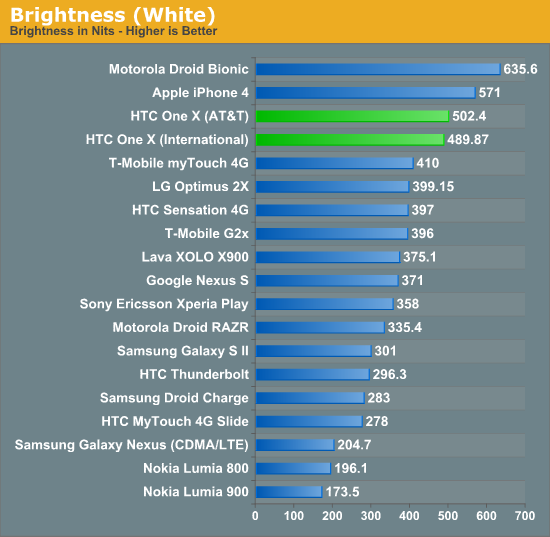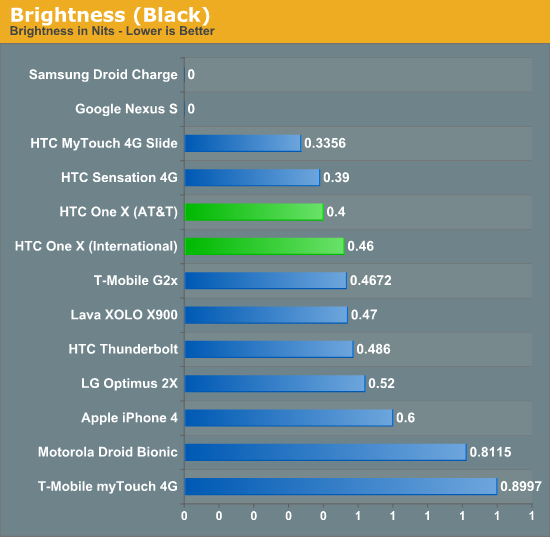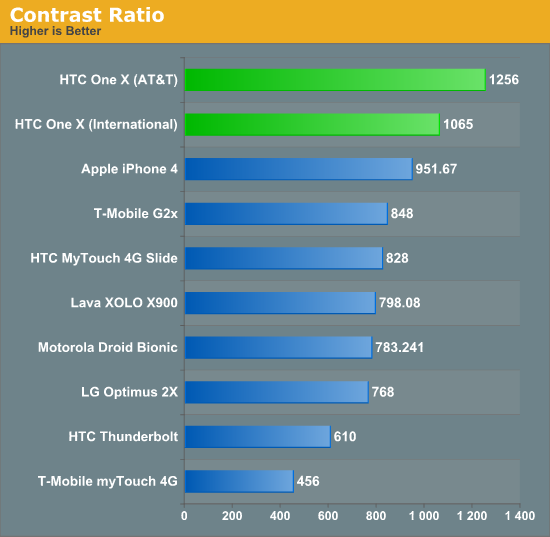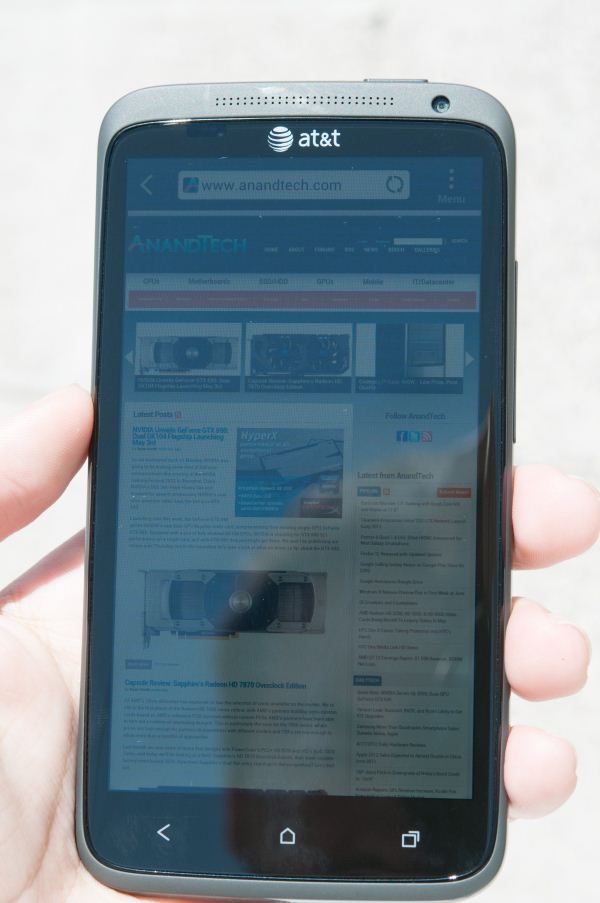The HTC One X for AT&T Review
by Brian Klug on May 1, 2012 6:00 PM EST- Posted in
- Smartphones
- Snapdragon
- HTC
- Qualcomm
- MSM8960
- Krait
- Mobile
- Tegra 3
- HTC One
- NVIDIA
The One X has a 4.7“ 1280x720 display that’s beautiful, dubbed the ”infinity screen.“ In fact, that’s really all you need to know about it - it’s absolutely wonderful, and honestly if you’re concerned with mobile displays just stop right there. At above 4.5” diagonal, 720p seems to be the new norm, and the combination of that 4.7" diagonal size and 720p on the HTC One X results in a PPI of 312. HTC shipped a device with an LCD display last year whose pixel density exceeded the iPhone 4/4S Retina Display for the first time in the HTC Rezound, which was 341 PPI.
Nevertheless the HTC One X still has subpixels small enough that I can’t visually distinguish them at all but from the most extreme distances. In addition, because it’s LCD you get an RGB stripe as opposed to PenTile RGBG like what currently ships on Samsung’s SAMOLED HD displays at 720p in the Galaxy Nexus.
I did some poking around, and my HTC One X (AT&T) review unit has a Sony display:
[DISP] mipi_video_sony_hd720p_init: assign initial setting for SONY_NT id 0x18103 Cut1, PANEL type = PANEL_ID_ELITE_SONY_NT



The panel goes extremely bright, at over 500 nits maximum, and has top of the chart contrast. As always I characterized the One X display using a combination of ColorHCFR and an i1D2 and Francois’ excellent Voodoo Screen Test Pattern generator application.
I’ve made both the color.chc file and measures available. The CIE diagram shows that HTC’s Infinity Display has very close to sRGB coverage, however color temperature is on the red side at just under 6000K. That’s really my only gripe, and curiously enough the One S with SAMOLED qHD displays are closer to 6500K than the LCD packing HTC One Xes.
Viewing angles look good on the HTC One X, there's no visible color shift at extreme angles. Outdoor viewing is also pretty good on the HTC One X, thanks in part to optical bonding between the display glass and LCD itself. One fewer air gap means fewer Fresnel reflections which quickly turn a display into a mess outdoors.
























137 Comments
View All Comments
Stormkroe - Tuesday, May 1, 2012 - link
The normalized portions is strictly for showing the efficiency of the phone as a whole package. In the case of the One X and XL, we get a rare opportunity to compare efficiencies without worrying about software, screens, battery manufacturer, etc, as they are all identical. We're then left with a pretty good grasp of how the S4 SoC compares to the Tegra3 SoC, as apples to apples as it's going to get. I'd suggest that maybe it's time you just started skipping over that part if you can't understand the relevance.sprockkets - Tuesday, May 1, 2012 - link
What about MHDL? What resolution does it output at?3DoubleD - Tuesday, May 1, 2012 - link
How come there wasn't any comment on the ludicrously small storage space on this phone? How is 16 GB of flash acceptable in a TOP END Q2 2012 phone?!?This thing costs well over $600 and we only get 16 GB of flash! How much does slow NAND cost? Would an additional 16 GB of storage really cut into the bottom line? How about making 64 GB standard? High performance SSDs are going for $1/GB, and the NAND in these phones is no where near that performance level... food for thought.
Why must HTC play down to Apple's level, then yet provide none of the upgrade options (which are in themselves insulting in a $600+ phone)?
weiln12 - Wednesday, May 2, 2012 - link
I agree completely here.I really don't care if there's expandable memory, I hardly (if ever) used it, I simply use DropBox now if I need to. However, I have over 12GB of music that I listen to every day. How in the heck do these Android phones get by with only 16GB of TOTAL space available?
I use a 32GB iPhone now, and part of me misses Android. However, as long as these "top-end" phones only have 16GB of memory, there's no way I can use them. It's a shame, because I'd really love to have a faster phone and better camera...but I can't give up listening to music.
metafor - Thursday, May 3, 2012 - link
Google music :)3DoubleD - Thursday, May 3, 2012 - link
The problem with stream music is that the majority of phone planes have data caps. Also, streaming music is more battery intensive than just playing local music files.Also, the way the partitions are for the One X, you only have 2 GB for apps, which is perhaps just enough for heavy users today; however, apps are getting bigger, not smaller. I suspect that 2 GBs of app storage space will be too small for a large number of users during the reasonable lifetime of this phone (next 2-3 years). If anything, they should have made it 3 or 4 GB, but then the insanely small amount of room for pictures and video storage would be a limiting factor. Their real problem is they were just too ridiculously stingy with the amount of integrated flash and it's a real shame because this is a beautiful device.
Goi - Tuesday, May 1, 2012 - link
Why is it that the One S performs better than the AT&T One X when they both use the same SoC?Impulses - Tuesday, May 1, 2012 - link
Lower res display, less pixels to drive.Goi - Wednesday, May 2, 2012 - link
Thanks...I could've sworn I saw the One S leading in non-GPU results as well, but a quick check shows that I remembered wrongly...Stormkroe - Tuesday, May 1, 2012 - link
Screen res, broseph. The one S is pushing less pixels.